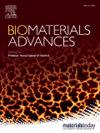Bio-inspired, programmable biomacromolecules based nanostructures driven cancer therapy
IF 5.5
2区 医学
Q2 MATERIALS SCIENCE, BIOMATERIALS
Materials Science & Engineering C-Materials for Biological Applications
Pub Date : 2025-02-15
DOI:10.1016/j.bioadv.2025.214235
引用次数: 0
Abstract
Cancer remains a significant global health challenge, driving the development of advanced platforms for highly targeted and efficient drug delivery. Early-stage nanocarriers, such as synthetic polymeric and inorganic materials, face limitations in biocompatibility and biodegradability. In contrast, bioinspired nanocarriers derived from natural biomacromolecules mimic biological processes and present a promising alternative due to their biocompatibility, biodegradability and non-toxicity. The effectiveness of these drug delivery systems is influenced by factors such as size, shape, surface properties, morphology, functionalization, and preparation methods. Various biomacromolecule-inspired nanocarriers such as protein-based, lipid-based, carbohydrate-based and nucleic acid-based are now at the forefront of research. This review highlights the properties, advantages and limitations of different bioinspired materials. We also explore cutting-edge approaches for cancer therapy using these nanocarriers with recent in-vitro, in-vivo and patent evidence. Finally, we address the challenges and potential solutions associated with bioinspired nanocarriers, proposing future directions. Overall, this review explores nature-inspired drug delivery systems that have paved the way for advancements in cancer therapy.
癌症仍然是全球健康面临的重大挑战,这推动了高度靶向和高效给药先进平台的发展。早期的纳米载体,如合成聚合物和无机材料,在生物相容性和生物降解性方面受到限制。相比之下,从天然生物大分子中提取的生物启发纳米载体模仿生物过程,具有生物相容性、生物降解性和无毒性,是一种很有前途的替代品。这些给药系统的有效性受到尺寸、形状、表面特性、形态、功能化和制备方法等因素的影响。各种受生物大分子启发的纳米载体,如蛋白质基、脂质基、碳水化合物基和核酸基纳米载体,目前都处于研究前沿。本综述重点介绍了不同生物启发材料的特性、优势和局限性。我们还通过最新的体外、体内和专利证据,探讨了利用这些纳米载体治疗癌症的前沿方法。最后,我们探讨了与生物启发纳米载体相关的挑战和潜在解决方案,并提出了未来的发展方向。总之,本综述探讨了自然启发的给药系统,这些系统为癌症治疗的进步铺平了道路。
本文章由计算机程序翻译,如有差异,请以英文原文为准。
求助全文
约1分钟内获得全文
求助全文
来源期刊
CiteScore
17.80
自引率
0.00%
发文量
501
审稿时长
27 days
期刊介绍:
Biomaterials Advances, previously known as Materials Science and Engineering: C-Materials for Biological Applications (P-ISSN: 0928-4931, E-ISSN: 1873-0191). Includes topics at the interface of the biomedical sciences and materials engineering. These topics include:
• Bioinspired and biomimetic materials for medical applications
• Materials of biological origin for medical applications
• Materials for "active" medical applications
• Self-assembling and self-healing materials for medical applications
• "Smart" (i.e., stimulus-response) materials for medical applications
• Ceramic, metallic, polymeric, and composite materials for medical applications
• Materials for in vivo sensing
• Materials for in vivo imaging
• Materials for delivery of pharmacologic agents and vaccines
• Novel approaches for characterizing and modeling materials for medical applications
Manuscripts on biological topics without a materials science component, or manuscripts on materials science without biological applications, will not be considered for publication in Materials Science and Engineering C. New submissions are first assessed for language, scope and originality (plagiarism check) and can be desk rejected before review if they need English language improvements, are out of scope or present excessive duplication with published sources.
Biomaterials Advances sits within Elsevier''s biomaterials science portfolio alongside Biomaterials, Materials Today Bio and Biomaterials and Biosystems. As part of the broader Materials Today family, Biomaterials Advances offers authors rigorous peer review, rapid decisions, and high visibility. We look forward to receiving your submissions!

 求助内容:
求助内容: 应助结果提醒方式:
应助结果提醒方式:


